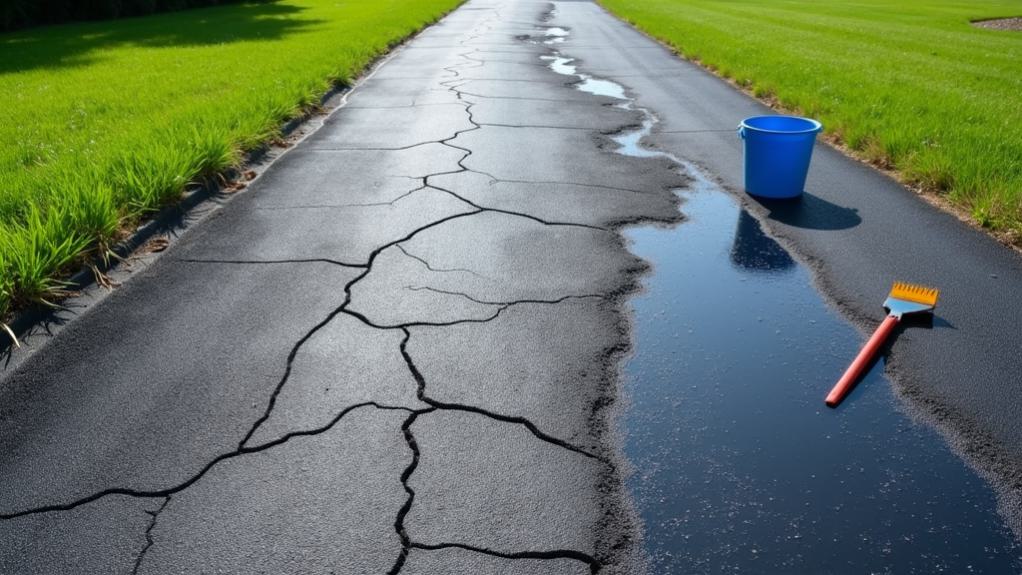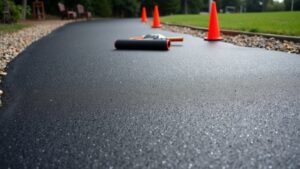You can repair an asphalt driveway by identifying damage signs like cracks, potholes, and surface distortions. Common techniques include crack filling, sealcoating, and pothole repair, tailored to the severity of the damage.
For minor issues, simple crack filling suffices, while extensive damage may necessitate patching or resurfacing. Consider the age of your driveway and its condition when choosing a method. Regular maintenance not only enhances curb appeal but also extends the driveway’s lifespan. If you’re facing significant issues or unsure about the required repairs, professional consultation can provide the expertise needed to restore your driveway effectively.
Key Takeaways
- Yes, asphalt driveways can be repaired using various methods depending on the extent of damage, including crack filling and pothole repair.
- Regular maintenance, like sealcoating, can extend the lifespan of an asphalt driveway by 10-20 years.
- Minor damage, such as small cracks, can be easily repaired, while significant issues may require professional evaluation and intervention.
- Repair costs vary, with minor fixes averaging around $100 and extensive resurfacing potentially exceeding $2,500.
- Timely repairs prevent further deterioration, saving up to 70% in potential future repair costs.
Signs of Asphalt Damage
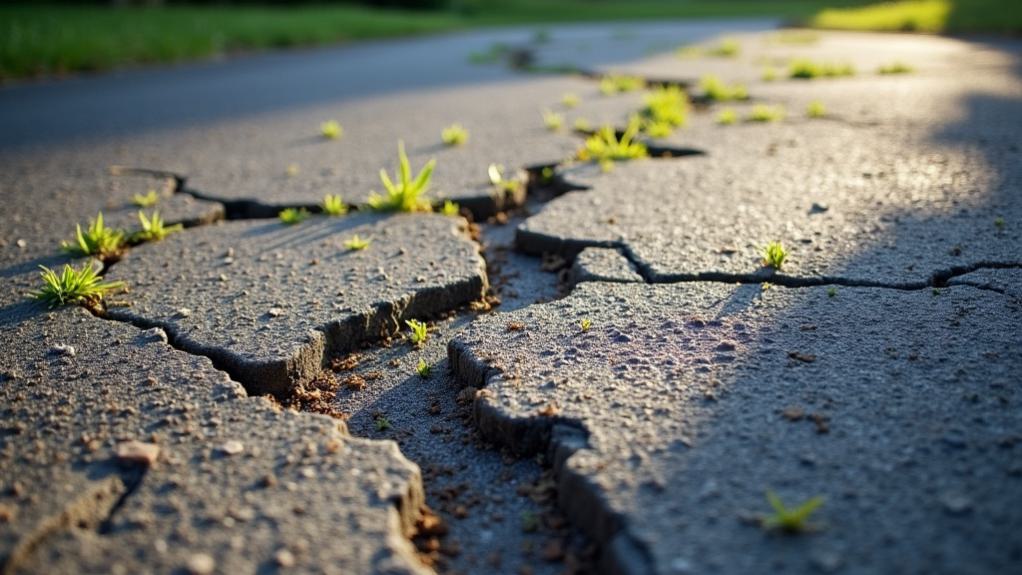
When evaluating the condition of your asphalt driveway, you should look for several key signs of damage. One of the most telling indicators is cracks in asphalt, which can manifest as reflection cracking, fatigue cracking, or edge cracks. Each type of crack signifies a different level of asphalt damage and requires your immediate attention.
Regular maintenance, such as pothole prevention and repair insights, can help you address these issues before they escalate.
Additionally, observe for distortions like depressions, bumps, tire ruts, and root upheaval. These imperfections can worsen over time, leading to more extensive issues if not addressed promptly.
Potholes are another serious sign of asphalt damage. They pose safety risks for both vehicles and pedestrians, making it essential to repair an asphalt surface as soon as they appear.
Water infiltration is another concern; unchecked cracks allow moisture to penetrate, leading to deterioration of the base layer. This can result in more costly repairs down the line.
Finally, pay attention to surface fading. A loss of color indicates aging asphalt and may necessitate maintenance actions, such as sealcoating.
Common Repair Techniques
Repairing asphalt driveways involves employing various techniques to address specific types of damage and maintain the surface’s integrity.
One effective method is crack filling, which uses a flexible rubber-like compound to seal non-spreading cracks. This prevents water intrusion that can lead to further deterioration of the asphalt.
Regular maintenance, such as sealcoating, is essential as it extends the asphalt’s lifespan and provides a protective barrier against damage.
For larger issues, pothole repair becomes necessary. Professionals typically use patching or resurfacing methods to provide a quick and durable solution, ensuring safety and preventing additional damage.
If the asphalt is severely compromised, cutting and patching can be employed, where sections of failed asphalt are removed and replaced, restoring the surface effectively.
Another valuable technique is overlaying, where a new layer of asphalt is added. This not only enhances the pavement’s structural integrity but also extends its lifespan by 10-20 years, making it a cost-effective choice for moderately damaged driveways.
Lastly, regular sealcoating every 2-3 years is vital. This protective layer guards against moisture and UV damage, considerably prolonging the life of your asphalt and reducing the need for more extensive repairs.
Using these techniques appropriately helps maintain a smooth and durable driveway.
Choosing Between Repair Methods
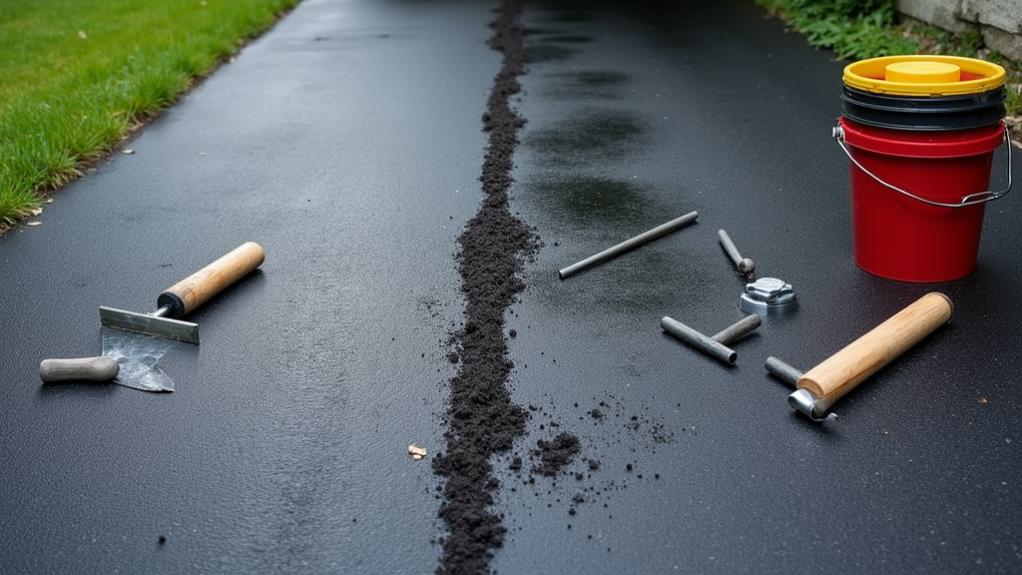
Choosing the right repair method for your asphalt driveway can greatly impact its longevity and appearance. Begin by evaluating the extent of the damage. Minor cracks can often be effectively addressed with crack filling, while larger potholes may require patching.
If your driveway shows multiple moderate damages, resurfacing an asphalt driveway is a cost-effective solution that enhances both structural strength and aesthetics. It’s important to take into account that regular maintenance, such as driveway patching, helps to extend the lifespan of your driveway and improve curb appeal.
Consider these emotional factors when deciding on a repair method:
- A smooth, well-maintained driveway boosts your home’s curb appeal.
- Timely repairs can prevent costly replacements down the line.
- A safe, crack-free surface protects your family and vehicles.
- Regular upkeep promotes pride in your property.
Additionally, remember that the age of your driveway plays a significant role in your decision. Driveways older than 20 years may be better suited for replacement rather than continual repairs.
Also, take note of weather conditions; ideal temperatures for hot asphalt work should be above 50°F, while cold patches serve as emergency fixes during colder months.
Cost Considerations for Repairs
Understanding the costs associated with asphalt driveway repairs is essential to making informed decisions about maintenance. The price of Asphalt Driveway Repair can vary greatly, with minor crack repairs costing around $100, while extensive patching or resurfacing projects can exceed $2,500. The cost largely depends on the damage’s severity and the area size.
Resurfacing typically falls between $1 to $3 per square foot, presenting a viable alternative to complete replacement, which can range from $3 to $7 per square foot.
Timely maintenance is vital; neglecting minor issues can lead to severe damage, resulting in costly full-depth replacements.
Cold patch repairs offer a temporary fix and are generally less expensive, making them suitable for emergencies during colder months.
However, hot patching provides a more durable solution when applied in warmer conditions.
Benefits of Regular Maintenance
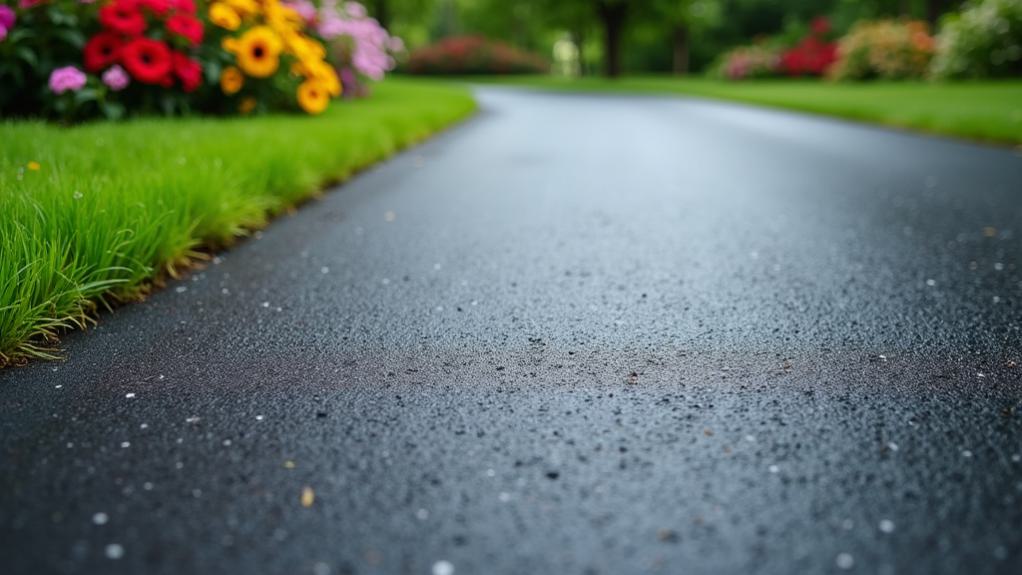
Regular maintenance of your asphalt driveway offers considerable benefits, enhancing both its longevity and appearance. By engaging in timely asphalt maintenance practices like using crack filler and applying driveway sealer, you can extend your driveway’s lifespan by 10-20 years.
Routine inspections allow you to catch early signs of damage, enabling immediate repairs that prevent more costly issues later on.
Consider these emotional benefits of regular maintenance:
- Protects your investment, guaranteeing your driveway remains a valuable asset.
- Enhances curb appeal, making your home more inviting.
- Reduces stress by minimizing unexpected repair expenses.
- Increases safety by addressing hazards such as potholes and cracks.
Sealcoating every 2-3 years is essential, as it shields your asphalt from UV radiation, moisture, and chemicals, greatly improving durability and aesthetics.
By promptly addressing minor cracks and potholes, you can save up to 70% in potential future repair costs, avoiding extensive repairs or full replacements.
Implementing proper maintenance practices, such as cleaning and sealing, guarantees your asphalt remains a reliable and cost-effective pavement material for years to come.
When to Consult a Professional
When you notice significant damage to your asphalt driveway, it’s important to consult a professional. If you see extensive damage like large cracks greater than 1/2 inch or multiple potholes, these issues typically require specialized repair techniques or resurfacing. Attempting simple patching may not suffice and can lead to ongoing problems.
If your driveway is over 20 years old and showing signs of wear, a professional assessment is important. They can determine whether a full replacement is more cost-effective than continual repairs. Additionally, if water infiltration is evident, causing erosion of the base layer, seeking professional help is critical. Addressing these underlying issues early can prevent costly repairs down the line.
You should also contact a professional if you observe distortions like depressions or rutting in high-traffic areas. Proper evaluation and restoration will maintain the driveway’s safety and functionality.
Conclusion
To summarize, repairing your asphalt driveway can feel like a monumental task, but it doesn’t have to be overwhelming. By recognizing the signs of damage and choosing the right repair method, you can restore your driveway to its former glory.
Regular maintenance not only extends its life but also saves you money in the long run. If the damage is extensive, don’t hesitate to consult a professional—sometimes, expert help is the best investment you can make.
